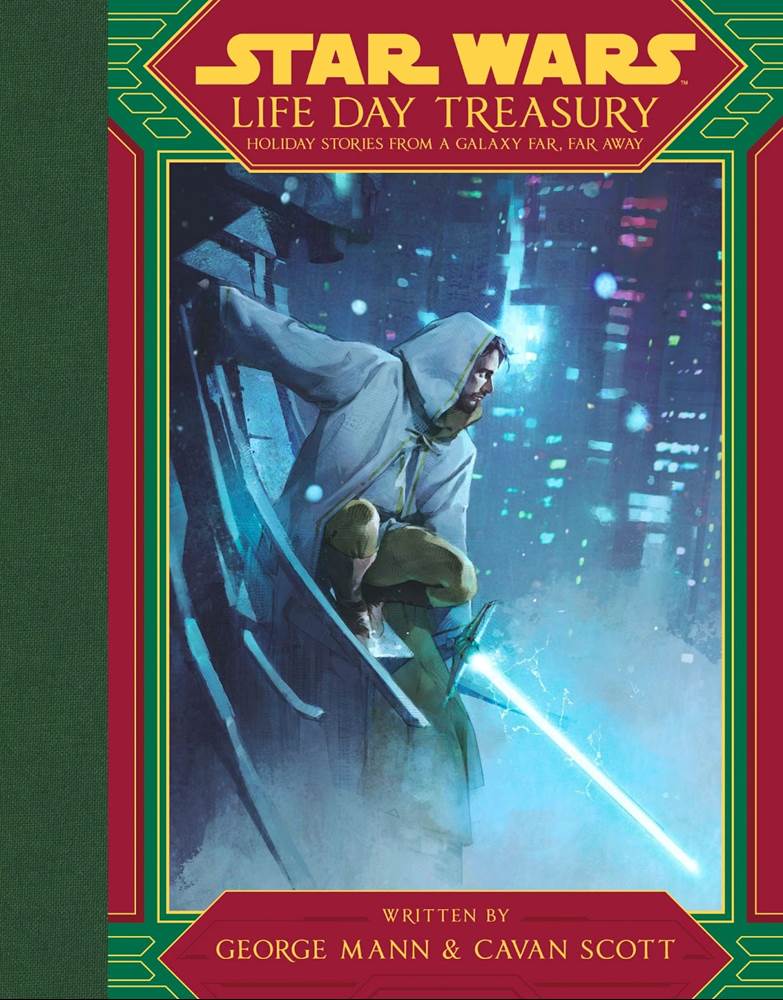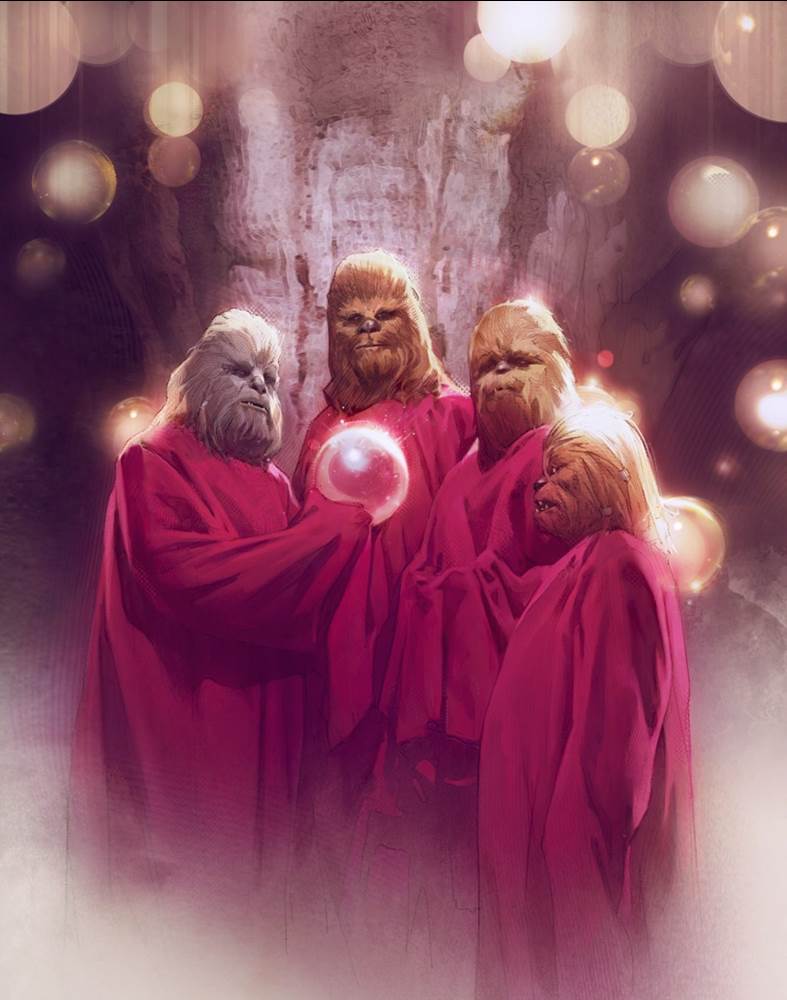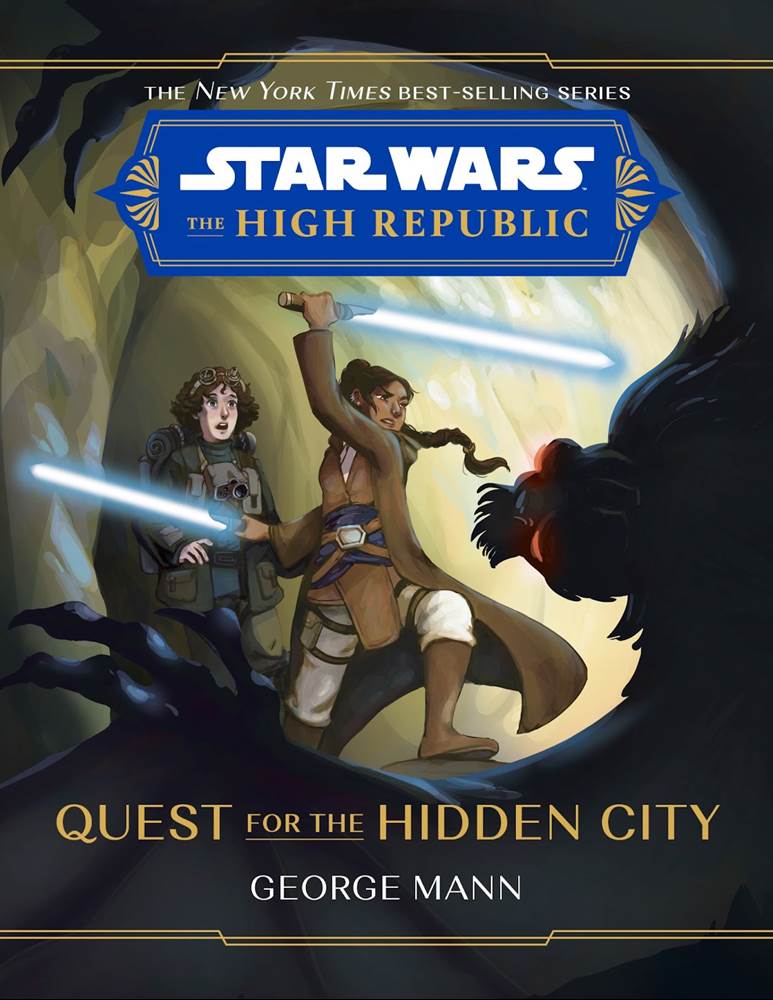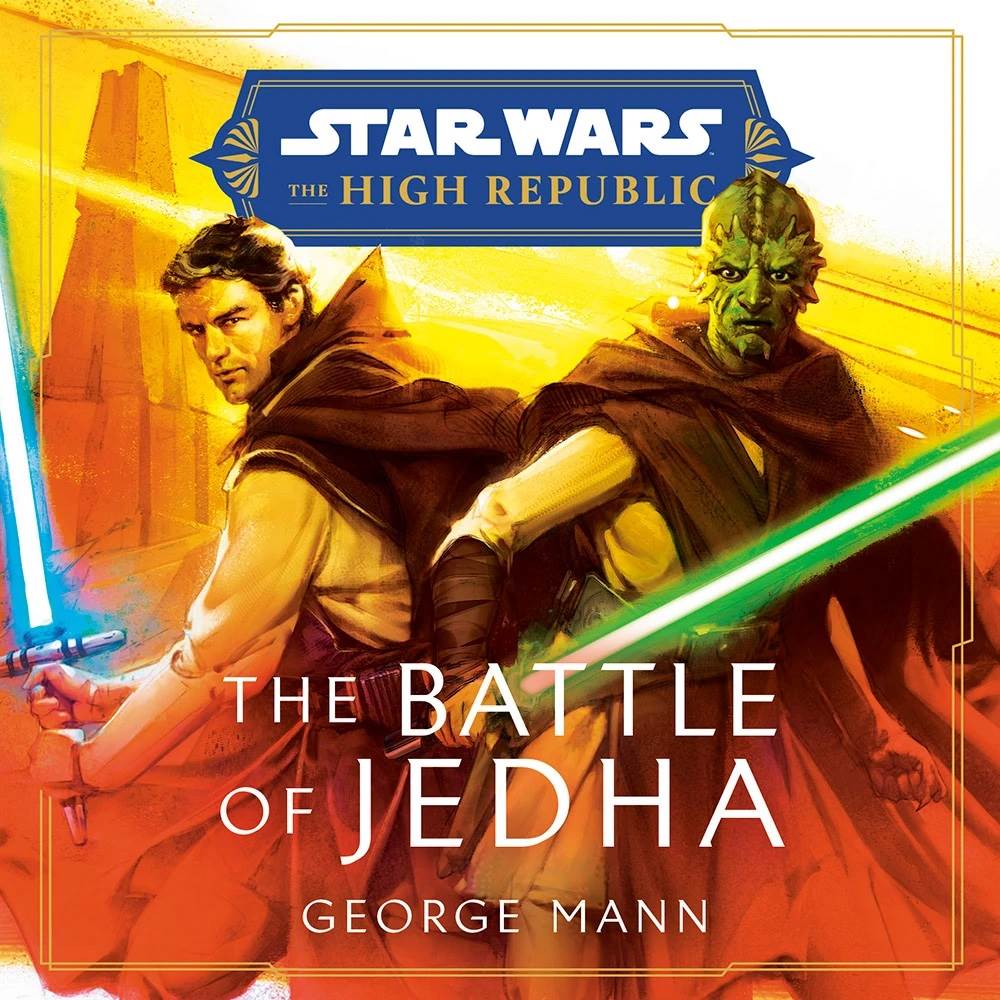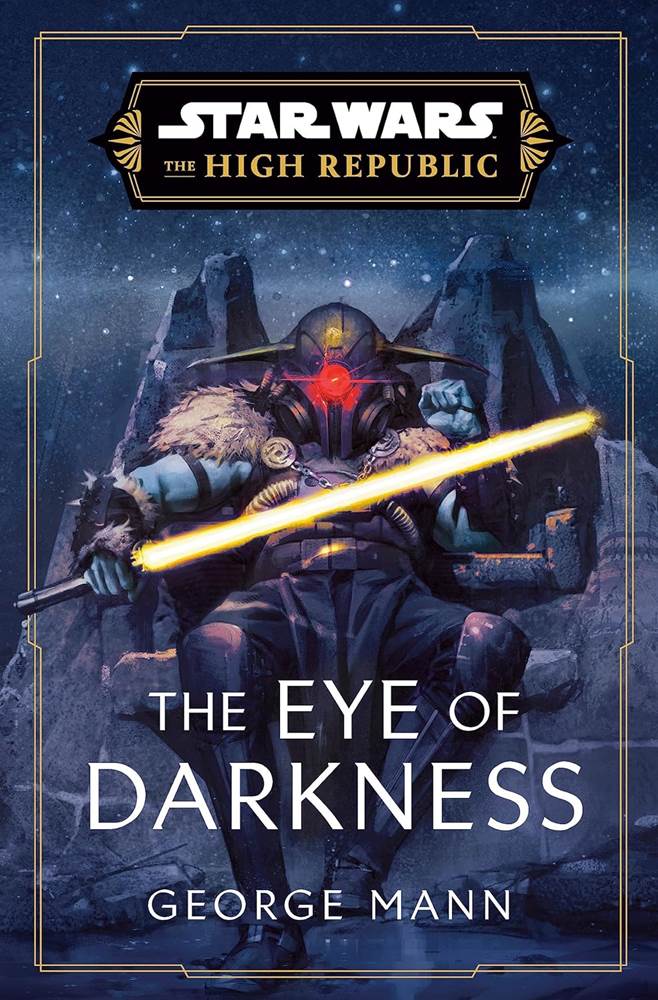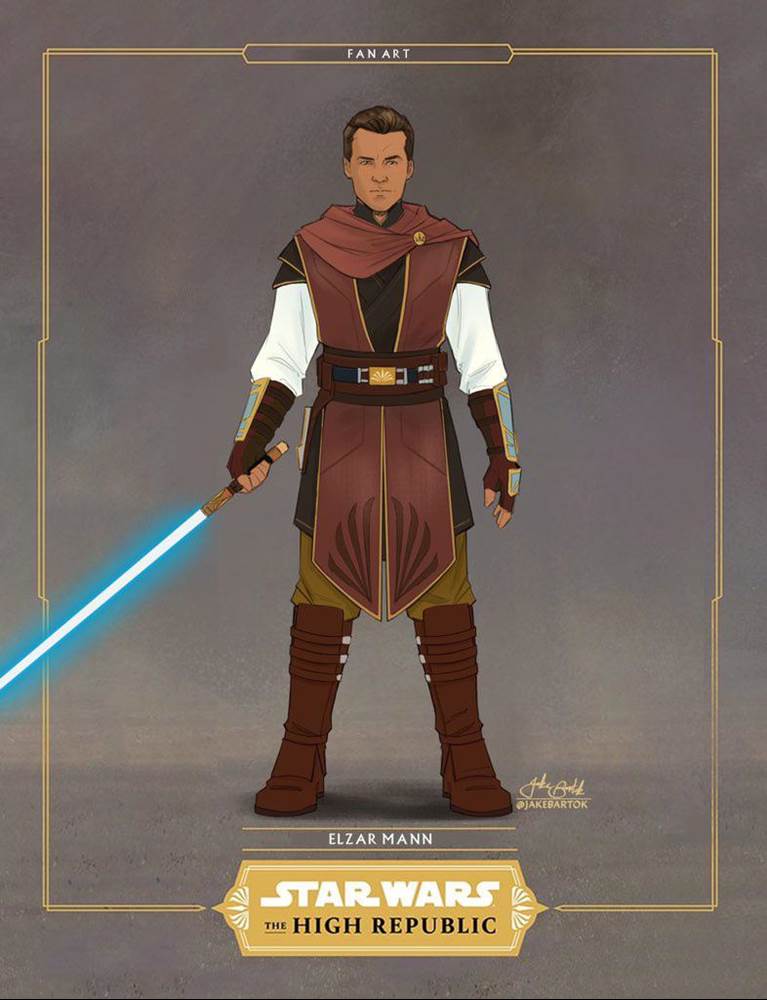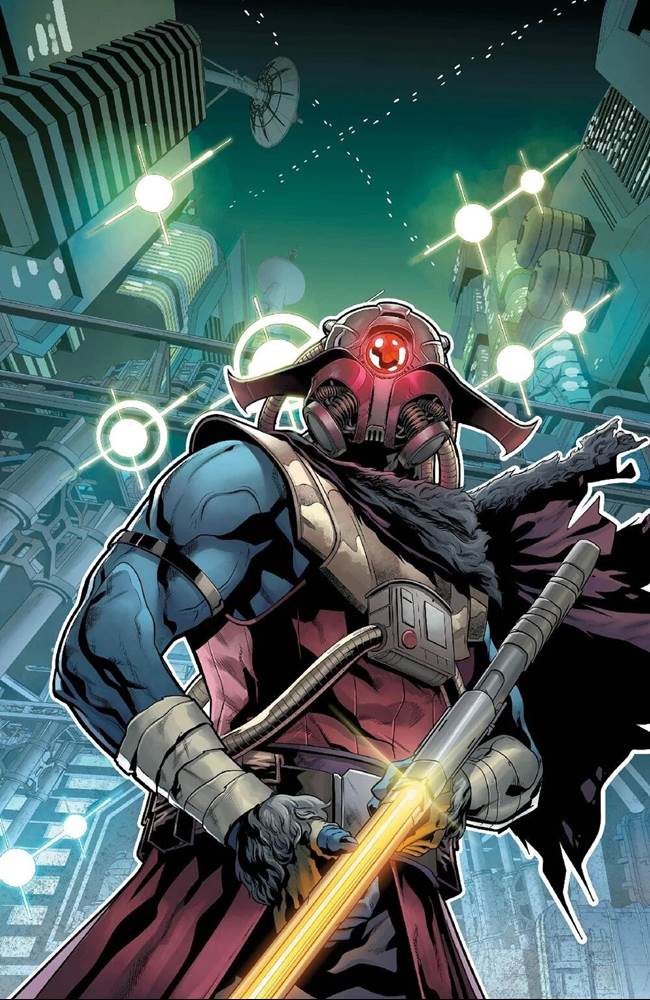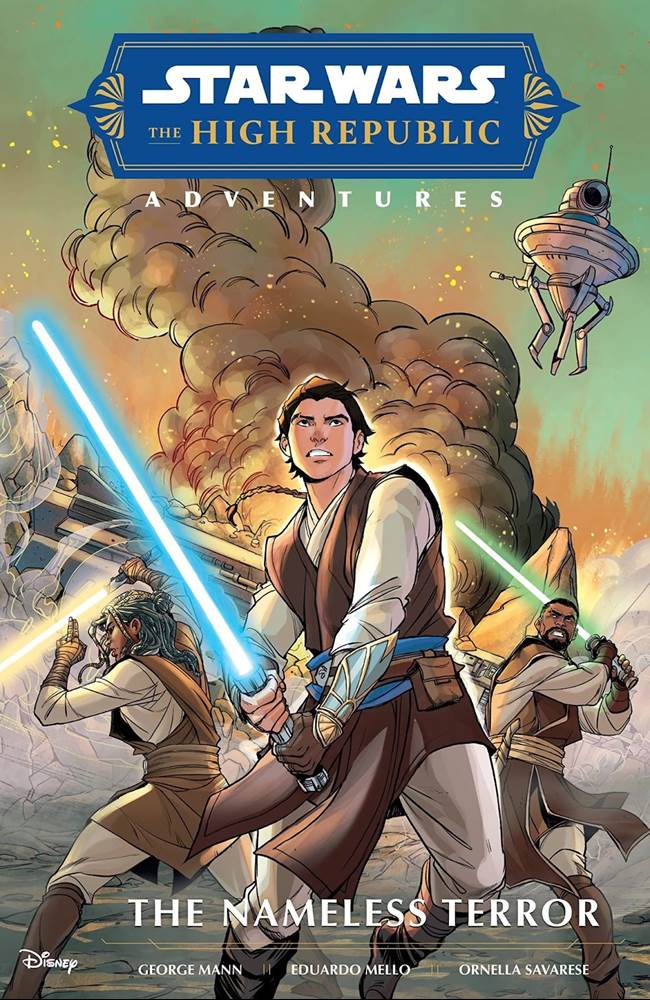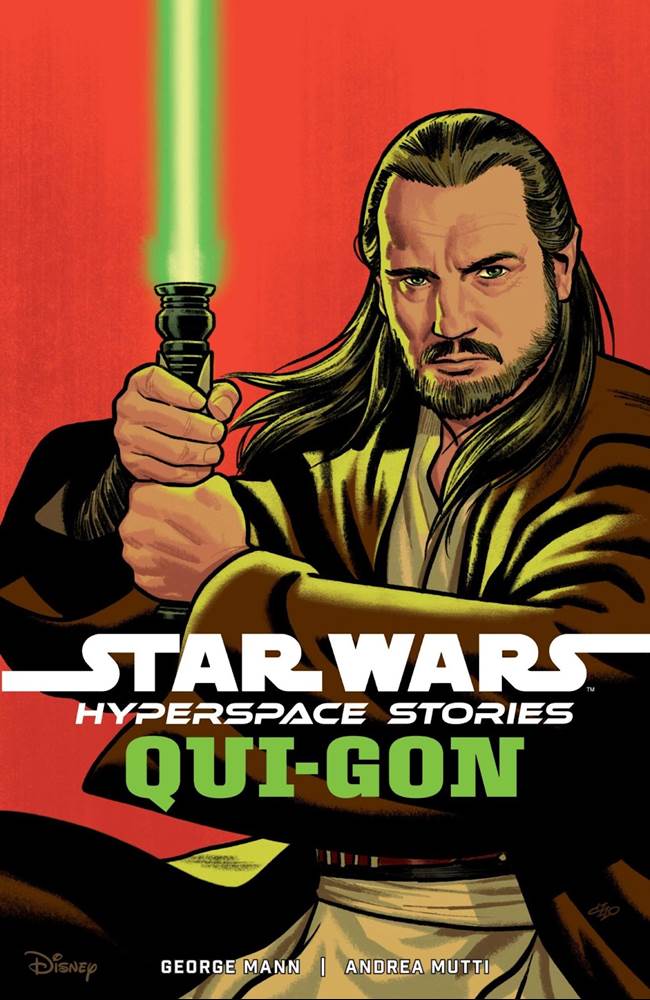After establishing a successful writing career for himself in genre fiction, British author George Mann has been contributing to the Lucasfilm Publishing universe since 2019, when his Star Wars: Myths & Fables short story collection was released to widespread acclaim from fans and critics alike. His new novel from Random House Worlds, Star Wars: The High Republic – The Eye of Darkness, came out last week to kick off Phase III of Lucasfilm’s ambitious multi-platform initiative. Yesterday I had the terrific opportunity to speak with Mr. Mann about his numerous Star Wars writing adventures and how The Eye of Darkness continues the already-storied legacy of The High Republic.
Mike Celestino, Laughing Place: We’re recording this interview just a couple hours after the big announcement that Dave Filoni has been named the Chief Executive Officer of Lucasfilm. I’m curious, as a Lucasfilm contributor, what was your response to this?
George Mann: “To be honest, I’m not hugely up to speed with the news yet. I’ve read the article in Vanity Fair. Congratulations to Dave for his promotion and his new role. It’s gonna be exciting, I think. I wait to see with bated breath what influence Dave is gonna have over the different parts of the franchise. I think he’s already proven with what he’s done so far that he makes great Star Wars– Rebels is one of my favorite iterations of Star Wars, ever. And for that reason, I hugely enjoyed Ahsoka recently, as well. So yeah, I’m waiting to see how this rolls out and how things develop, but congratulations to him. I’m sure it’s gonna be [an] exciting future.”
LP: I noticed in The Eye of Darkness that you used some terminology from The Mandalorian in The Eye of Darkness, like you have the Ugnaught character say “I have spoken.” How have these recent live-action Star Wars series affected you as a fan?
Mann: “As a fan, I’ve got live-action Star Wars on the TV. I mean, that’s huge. I love the movies– of course I love the movies– but what I particularly love about TV shows is it’s long-form storytelling. It’s serialized storytelling, which is similar to what we do in books and comics. You can tell more expansive stories, and I think it’s been wonderful to see that happening to live-action Star Wars as well– to get these interwoven, longer-form stories. And obviously what Jon Favreau and Filoni are doing with the Mandoverse, they’re telling an even bigger story. They’re weaving these multiple threads of different shows through this era that they’re building out in Star Wars post-Return of the Jedi. That’s hugely exciting as a fan, because it’s the meat and potatoes– it’s what you want. In regard to keying into that stuff and doing things like the Ugnaught Belin saying ‘I have spoken,’ you’re absolutely right. I think these things develop hand-in-hand. Star Wars is not a static galaxy. It’s always developing as more and more stories are contributed to it, whether they are video games, comics, books, TV, audio, movies, even toys.
We’re all pulling in the same direction and expanding out the Star Wars universe, and I think where we can have those points of consistency between things, it adds to the consumer experience. People who’ve come to the novels having watched the TV show, meeting an Ugnaught character, are gonna expect him to say ‘I have spoken.’ That’s an Ugnaught thing now, and it’s been shown on TV. I guess the truth of it as well is that more people watch the TV [shows] and the movies than read the books. To them, that is Star Wars, so then if you don’t pull those threads through, it’s gonna feel inconsistent to them and it’s gonna pull them out of the immersive experience of reading the book. ‘Why does this Ugnaught sound different from the one I’ve seen on TV?’ So I think it’s really important for us to do it– I think it’s part of the job as a writer and contributor to Star Wars, to be aware of what everyone else is doing, to watch it and see where those threads can be pulled. To make that universe feel… not smaller, because I think that’s something we’re always concerned about: we never want to make the galaxy feel small, because it’s not. There are so many worlds, and so many different places to explore in the Star Wars galaxy. But to have a consistency, I think is really important. So that’s why I draw on those things. I love the shows.”
LP: Since the last time I spoke with you one-on-one, you wrote and released the Star Wars: Life Day Treasury short-story anthology. What about that project was particularly satisfying for you as a writer?
Mann: “There’s a lot, actually. It ticks a lot of boxes for me, that project. First of all, I love writing the Myths & Fables-type stories, obviously– this was the third book I’d done in that series. But I love working with my friend Cavan Scott, as well. We’ve been friends a lot longer than we’ve written together. [Life Day Treasury] came about because Cav was pitching to [Lucasfilm Publishing creative director] Mike Siglain, ‘I want to do a Life Day storybook,’ and I was pitching, ‘I want to do more Myths & Fables.’ And [Siglain was] like, ‘Hang on a minute, you guys know each other.’ We don’t just know each other– we’re really good friends. He’s like, ‘You should write the book together.’ And we went, ‘Yeah, that’s great,’ because we’d written stuff for Doctor Who together before, as well, and a few other projects. One of the reasons we’re such good friends is we share a lot of cultural touchpoints: we both love folklore and mythology, we both love autumn and winter as seasons, we both love classic Christmas ghost stories.
There’s a really big tradition in Britain called ‘Ghost Stories for Christmas,’ which is where they adapt M.R. James short stories on the BBC, and you get one every year. And obviously from A Christmas Carol onwards, there’s been this tradition of spooky Christmas stories, so we love that as well. And obviously both of us love Star Wars– so it was a combination of all of those elements, being able to [say], ‘Let’s do Ewoks in the snow. Let’s do a story that’s reminiscent of the famous World War I Christmas truce. Let’s do a spooky story about Sith.’ We got to tell all these different types of stories, and we just spent some brilliant days together, just coming up with storylines and lots of different ideas. And then we allocated them– half to Cav and half to me, and we went away and wrote first drafts. It’s really interesting now, a little bit down the line, neither of us can really remember which ones we wrote first. What we did was we wrote them, then switched them over and rewrote each other, then switched them back and rewrote each other, until we were both happy with the stories. What that means now is we can’t even remember who did what words, but that’s a good sign of the trust between us, that we’re not precious.
We’ve worked on projects since, together, as well, and we can rewrite each other knowing that what we’re doing is for the best of the story, not because we have a particular angle or agenda. But for me, it was that, [and] it was deepening the lore of Life Day, as well. I love how Life Day has come from the Holiday Special, and is now such a part of Star Wars lore and fandom. Everyone’s saying to each other on social media, ‘Happy Life Day!’ and sending the Wookiees holding globes. It’s just brilliant, so we were able to contribute to that. There was a lovely thing last year– some of the work we’d done in those stories was translated into a pop-up book for Life Day, as well. And that was great to see, because we’re seeing some of the lore we’ve introduced in those stories start to percolate out. A bit like [what] we were talking about with the Ugnaughts and things– sometimes it happens that way ‘round, as well, and you get these little bits [from the books]: people celebrating Life Day at Batuu [in Star Wars: Galaxy’s Edge] and you’d like to think some of them are telling those stories to each other, or reading that book. They’re meant to be in-universe stories that are told. It was a lot of fun to do, and I myself come back to the book each year, and dip back into it and remind myself of the stories.”
LP: What is your relationship with the Star Wars Holiday Special?
Mann: “I didn’t come across it for years, actually. I forget when it was exactly, but someone had a VHS of it and showed it to me. I had missed it at the time [when it aired], because I was born in ‘78, so I was a bit young. I think [The Empire Strikes Back] was the first movie I saw at the theaters, and then from that point on every [Star Wars] film since. But somewhere in there, I think it was probably a cousin– I had a cousin who was really into Star Wars as well, a little bit older than me– I suspect he was the one who got hold of a recording and showed me. I remember being a bit baffled by it. [laughs] It’s very much of its time– it’s like a variety show of its time, but then also there’s cool stuff in there like Lumpy and Boba Fett. I think as a piece, now, it’s not seen as canon. But actually, there’s a generation of Star Wars creators who grew up and are now embracing elements of it, and pulling those elements into different stories and canonizing. So bit by bit… one day, every element of that Holiday Special will be canon, because it’s been made canon in a different context. You mark my words. [laughs]”
LP: Let’s get into The High Republic. Over the past couple of years you’ve written Quest for the Hidden City, The Battle of Jedha audio drama, and The Nameless Terror comic-book miniseries. What aspect of each of these projects was most interesting to you?
Mann: “I was very lucky in that, because of [the Star Wars short story anthology] Dark Legends, I was introduced to The High Republic a little bit earlier, because I wrote a Drengir story for the Target special edition. And at that point, Mike [Siglain] had said, ‘Here’s all the information on the Drengir. Here’s the big NDA you have to sign. And also, here’s the rest of the information about what we’re doing in The High Republic. Read it all, because it might become useful to you at some point. So he already had that plan at that point, to bring me in, and I ended up doing those picture books for Phase I, as well. Because I was already in the loop, and I was reading the manuscripts as the authors were writing them. So it was a huge honor to then be asked to become one of the main writers for Phase II, and immediately I latched onto the Pathfinders as a concept. Quest for the Hidden City is where that is expressed mostly, I suppose, from the stuff that I’ve written.
It’s the idea of frontier Jedi going out in teams– half Jedi, half Republic– to make contact with different planets and help people on the frontier where it’s needed, to establish communications, to introduce the concepts of the Republic, and what they might meet out there in these distant lands far from home. Which is why, I suppose, I took the tack with that book of meeting something terrifying on the frontier. The whole setup for that was, one team’s gone missing [and] another team goes to find them. What’s got them? With an environmental story wrapped into it, so it had a strong moral theme for the age group it was aimed at. But it was the Pathfinders in that book, particularly, that got me excited, and then we used the Pathfinders again in The Nameless Terror– brought one of those characters over, Rok, but took a different tack, really. That’s them stranded on a planet in a crashed ship with Nameless stalking them, and I just wanted to make the Nameless seem really scary. Although it’s an all-ages comic, it’s very much inspired by that kind of base-under-siege, trapped, nowhere-to-go, and the monsters are closing in sort of [story]. And there’s potential enemies inside the ship with them, as well. So that was a lot of fun to write.
Battle of Jedha was a completely different experience. I was looking at different aspects of Star Wars mythology that I love– the components of Star Wars. There was the faith-based stuff and the Force-based stuff– Jedha is obviously the heart of that, and introducing different sects and exploring people’s beliefs, particularly through the Path of the Open Hand and what they’re doing. But then also the politics of Star Wars has always been a big factor, particularly obviously in the prequel series, as well. That’s what’s going on here: you’ve got politics bubbling over and turning into a very messy situation in The Battle of Jedha. I think my favorite elements of that were bringing back Silandra Sho from Quest for the Hidden City, because I loved creating Silandra as a Jedi and her shield, but also exploring the bar, Enlightenment, and the characters that I also then used for the short stories that were running in Star Wars Insider. [They were] a Cheers-style crew in the bar– [a] different person walks in and tells a story every issue. I was writing those concurrently, and every time I was writing a story with them, I was like, ‘Oh no, I have to put these guys more into the audio’ and just build that up. So yeah, the whole of Phase II was just huge for me. I wrote a lot, and I thoroughly enjoyed every minute of it.”
LP: It’s been a week since the release of The Eye of Darkness. What are your thoughts on the reactions this novel has been getting?
Mann: “I mean, it’s phenomenal. I’m absolutely blown away by the response. There are people who are messaging me saying, ‘I’m on my third read.’ I’m like, ‘It’s only been out a week, guys.’ [laughs] But people have been so kind, and there’s a certain amount of relief from my point, as well, partly because I’ve been carrying this story for a long time. I’ve been working on this story for a while, and then I’ve been anxiously waiting to see how people will find it. A certain amount of nerves come with launching Phase III, but people seem to be enjoying it. I’ve had an overwhelmingly positive response from people– I think people were very keen to get back to some of these characters.”
LP: This novel marks your first time writing an “adult” Star Wars book. What’s the difference in your approach between this and the other media you’ve contributed to the franchise?
Mann: “It’s interesting; my background is in adult novels. For years and years and years, as a writer producing original fiction, it’s always been adult fiction. I came to Star Wars through that, and did the Myths & Fables books for an all-ages audience, and realized I can write for different age groups, as well. For me, I’m very keen to never patronize a younger audience, for example, so I don’t necessarily approach writing a middle-grade or a YA book differently, other than you’re writing from the perspective of characters of those ages. You’ve got to shift gears and go, ‘What are the preoccupations of a 14-year-old?’ They might be a Jedi, or a Jedi Padawan, or even a Youngling, but they’re still kids. So, ‘What are the preoccupations of kids?’ It helps being a parent, that I’ve seen my kids go through these different stages. With YA, it’s more like young adults and teenagers– ‘What are their preoccupations?’ They are often going through dealing with uncertainty and change, and coming of age, so you’re seeing the Star Wars universe through their eyes. The framework of the story doesn’t necessarily have to be that different– obviously a bit less complex.
And I think for me that’s one of the benefits of going into Eye of Darkness and writing this adult novel: it was the depths, the room that I had to expand. I really didn’t have to rush through scenes or compress things. You can have subplots, you can have multiple characters, you can really dig deep into character motivations and characterization, and start looking at the darker elements of the Star Wars universe in a way that it’s harder to do from a young person’s perspective. I always wanted Eye of Darkness to be a character study of those core characters, as well as hopefully being a thrilling Star Wars story, in the sense that you’ve got lightsaber battles and action sequences, and all the things that you need to have in a Star Wars story, that make it a Star Wars story. I also wanted to go, ‘Okay, what effects have the events of Phase I and the interim year had on these characters that we know and love? How are they feeling about this stuff?’ To me that was a really interesting angle and way to approach the book. Being able to write a book that’s 115,000-120,000 words meant I could really spend time exploring that without having to just bounce from action scene to action scene. So yeah, that was the benefit to me of getting back into writing adult novels.”
LP: For those who may not have read it three times yet, without spoiling anything, what can you tell fans about where they might find their favorite characters at the beginning of this novel? What’s the status quo of the galaxy as The Eye of Darkness is beginning?
Mann: “The status quo is the Jedi and the Republic are on the back foot. They’ve pretty much lost. You’ve had the Great Disaster, you’ve had the attack on Valo, you’ve had Marchion Ro dropping Starlight Beacon into the oceans of Eiram, and then the raising of the Stormwall. Marchion Ro has raised this great barrier across a whole section of space, and basically shut out the Jedi and the Republic, and also enclosed those worlds and anyone who was behind the barrier at that time. So you’ve got this segmented galaxy: the Nihil on one side, ruling the roost, the Republic on the other. On top of that, the Jedi are very conscious of the fact that not only has this guy beaten them on every level, he’s also got a weapon that can really hurt them or kill them– the Nameless. So they’re running a bit scared; they’ve pulled back to Coruscant, and things are looking dark. Because they’ve had a year since the Stormwall went up; it’s been a year since Starlight Beacon went down, and they’ve not made any progress. Some of them are trapped behind the Stormwall, or missing / presumed dead.
They don’t know what’s going on; they’ve still got all of the rest of the Republic to worry about. They’re not just focused on the Nihil problem– they’ve also got all these other worlds that need their help on a regular basis. Elzar Mann is right at the heart of that: he’s on Coruscant, he is feeling guilty about what happened on Starlight Beacon when he killed Chancey Yarrow, [he] blames himself for Stellan [Gios’s] death, he blames himself for driving Avar [Kriss] away. Avar is on the other side of the Occlusion Zone, and he doesn’t know whether she’s alive or dead. As readers we do find out that she’s alive, and we follow her. Stellan’s gone and Elzar is trying to live up to the person he thinks Stellan was. He’s promised the universe, ‘I need to fill the hole that’s been left by Stellan.’ But he’s also trying to be a bit of Avar as well, because she’s missing. And actually, the problem is it’s breaking him, because he isn’t these people. What Elzar needs to do is he needs to remember that what’s needed of him is to be Elzar, because Elzar is actually a good guy who’s good at what he does. He doesn’t need to be other people– he needs to be himself.
That’s an important message, really; that’s part of his arc through the book. And Avar’s mirroring that on the other side of the Occlusion Zone. She’s struggling, she’s also blaming herself for what happened, and she’s thinking that she’s not worthy of the big titles that she had: “Hero of Hetzal” and “Marshal of Starlight Beacon,” this guiding light of the Jedi. She’s like, ‘Actually, I didn’t live up to it. Everything I did went wrong.’ So she’s retreated to a past state, in the sense of she’s going, ‘Well, I know how to be a Jedi, and get up every day and do something good.’ That’s what she’s trying to do, but it’s all so small-scale, and she’s hoping that all these little small-scale wins will add up to something bigger. But she needs to remember that she actually needs to be part of something bigger, and embrace everything that’s happened, and believe in herself again. So that’s where those two are. Bell [Zettifar is] out on the edge of the Occlusion Zone with [Burryaga]. Bell’s really angry at the Nihil about everything that’s happened, and Burry’s acting like his conscience a little bit. He’s the guy that’s keeping his friend on the right path, reminding him, ‘Actually, you don’t have to take this all on yourself. Anger isn’t gonna get you where we need to be.’
So those two are working as an interesting pair, and Burry’s the only guy who’s having a bit of a good time– in the sense of, he’s not happy about the Stormwall, he’s not happy about the Nihil, but he is happy to be alive after what happened to him. He’s happy to be amongst people he loves, and his friends, and he’s trying to remind Bell of that, as well. And then interestingly for me, is where Marchion Ro is at, because he’s the guy who’s won. But there was a pivotal moment in the writing of the book for me when he’s talking to Ghirra [Starros], and he just lets his guard slip a little bit and admits, basically, ‘By winning, I’ve lost, because I’ve had to become my enemy.’ For me, that was the pivotal moment in unlocking the theme of the book, because he’s put the Stormwall up but he’s trapped himself in a prison in the process. He doesn’t want to be governing worlds, he doesn’t want to have an organization. He doesn’t want to become the Republic Mark II. He’s an agent of chaos, and he’s feeling boxed in by that. And I think that makes him even more dangerous.”
LP: How did you communicate with and work with the other High Republic authors to come up with what your story was going to be here at the start of Phase III?
Mann: “It’s an interesting process– obviously there was a certain framework that had been put together a long time ago by the original ‘Architects’ team deciding, ‘We’re gonna do Phase I, then we’re gonna go back in time and do Phase II like George Lucas with the prequels, then we’re gonna come and bring Phase III.’ So there were some broad strokes– [a] general direction already agreed [upon]. And then we just talk a lot: we have a Slack amongst us, we have regular meetings with Mike Siglain, and we work all this stuff out between us. It’s been announced already that Tessa [Gratton is] writing book two for Penguin Random House, and Charles [Soule] is writing book three. So the three of us, we talked about, ‘This is what’s gonna happen in book one, this is what’s gonna happen in book two, and this is what’s gonna happen in book three.’ And that collaboration gives rise to loads of great little links, and then you broaden that out and you take it to the rest of the team and we say, ‘This is what’s happening in these books. How are they gonna interact with the YA books and the comics and the audio [dramas], whatever is being written?’
And that’s how we’ve always worked. With [the Marvel Comics miniseries that bridges the gap between Phases I and III] Shadows of Starlight, we’d already planned the trajectory of the three books– and that doesn’t mean that you don’t have a personal opportunity when you write the book to express things the way you want to write and to take things in a slightly different direction, but you work with the team. You say, ‘The characters have told me they want to do this. How does that work? Does that fit? If I change this thing in our plan, is that still gonna work?’ And then you use a bit of bargaining and negotiating: ‘I don’t want to spoil someone’s story, but can I use this character to do this thing?’ We do give-and-take on that. With Shadows of Starlight, I wrote a first draft of Eye of Darkness, Charles read it, gave me some feedback, we passed it around. He then planned Shadows of Starlight while I was doing the rewrites on the book, so that we could draw those links. We worked out between us, really– and with the wider group– the key beats for what was gonna happen in each issue, and the book.”
LP: Over the past few years fans have gotten used to having their emotions put through the wringer by The High Republic. Without spoiling anything, can you just tease a little bit about how that trend continues in The Eye of Darkness?
Mann: “Any good story’s gonna pull at your heartstrings. We don’t sit there and say, ‘How can we really upset people?’ I think it’s because we care about these characters, and we want to put them through these difficult trials. And it’s because the readers have come to care for these characters, and don’t want them to face these horrific situations. Which is brilliant, and it’s a testament to the writers that have come before me. With what I’ve done [in this novel], this is the ‘long dark night of the soul’ for the Jedi and for The High Republic. If you think in terms of traditional story structure, we’re at that point where the heroes are at their lowest. But what that means is, hopefully, things can only get better from here. I’m not promising anything. [laughs] But I think there’s an important thread of hope through the book, as well. Because for me, Star Wars is always about hope. That’s really what Avar’s story is bringing to the book– it’s the rekindling of hope. Even in the darkness, there’s hope. That’s the thing to cling onto when we’re going through that emotional rollercoaster.”
LP: What else is coming up for you as a writer, in Star Wars or otherwise?
Mann: “Well, recently it’s been all Star Wars all the time for me, which has been a lot of fun. There [are] two Star Wars projects that have been announced: there’s Tears of the Nameless, which is the second YA book for The High Republic Phase III, and there’s the Qui-Gon original graphic novel. I’ve been giving people three words as a tease for Tears of the Nameless: ‘Reath, Azlin, and Fear.’ But this is an exclusive for you today– three words for Qui-Gon, as well: ‘Humidity, Padawan, and Dark Side.’ And there’s a little return to Jedha in there, as well.”
Star Wars: The High Republic – The Eye of Darkness is available now wherever books are sold, while Star Wars: The High Republic – Tears of the Nameless is due out next fall and Star Wars: Hyperspace Stories – Qui-Gon will be released in July. The audio version of this interview is featured in this week’s episode of Laughing Place’s Star Wars podcast “Who’s the Bossk?”


